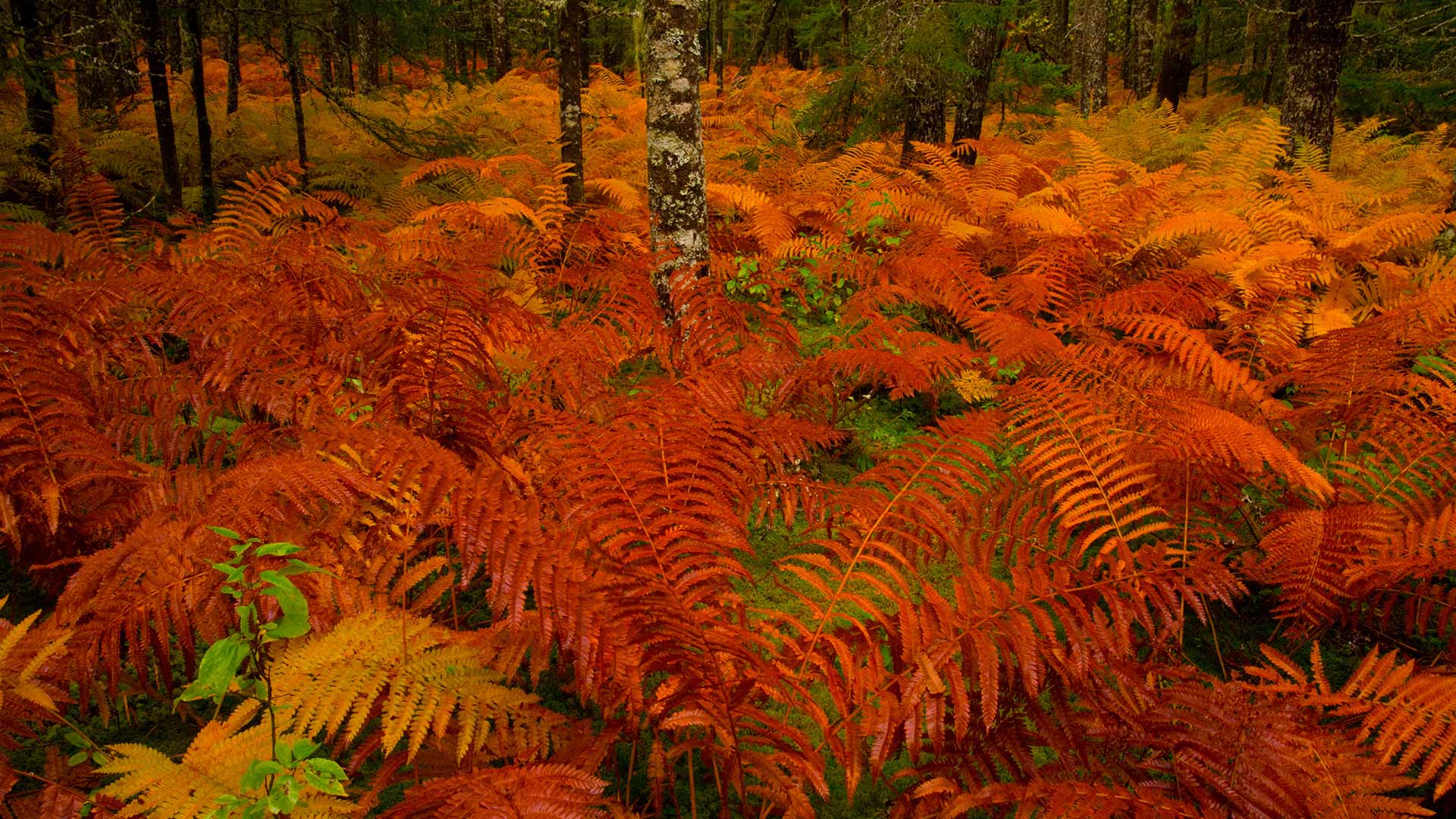标签 墨西哥 下的文章
加勒比火烈鸟,尤卡坦半岛,墨西哥 Caribbean flamingos, Yucatán Peninsula, Mexico (© Claudio Contreras/NPL/Minden Pictures)
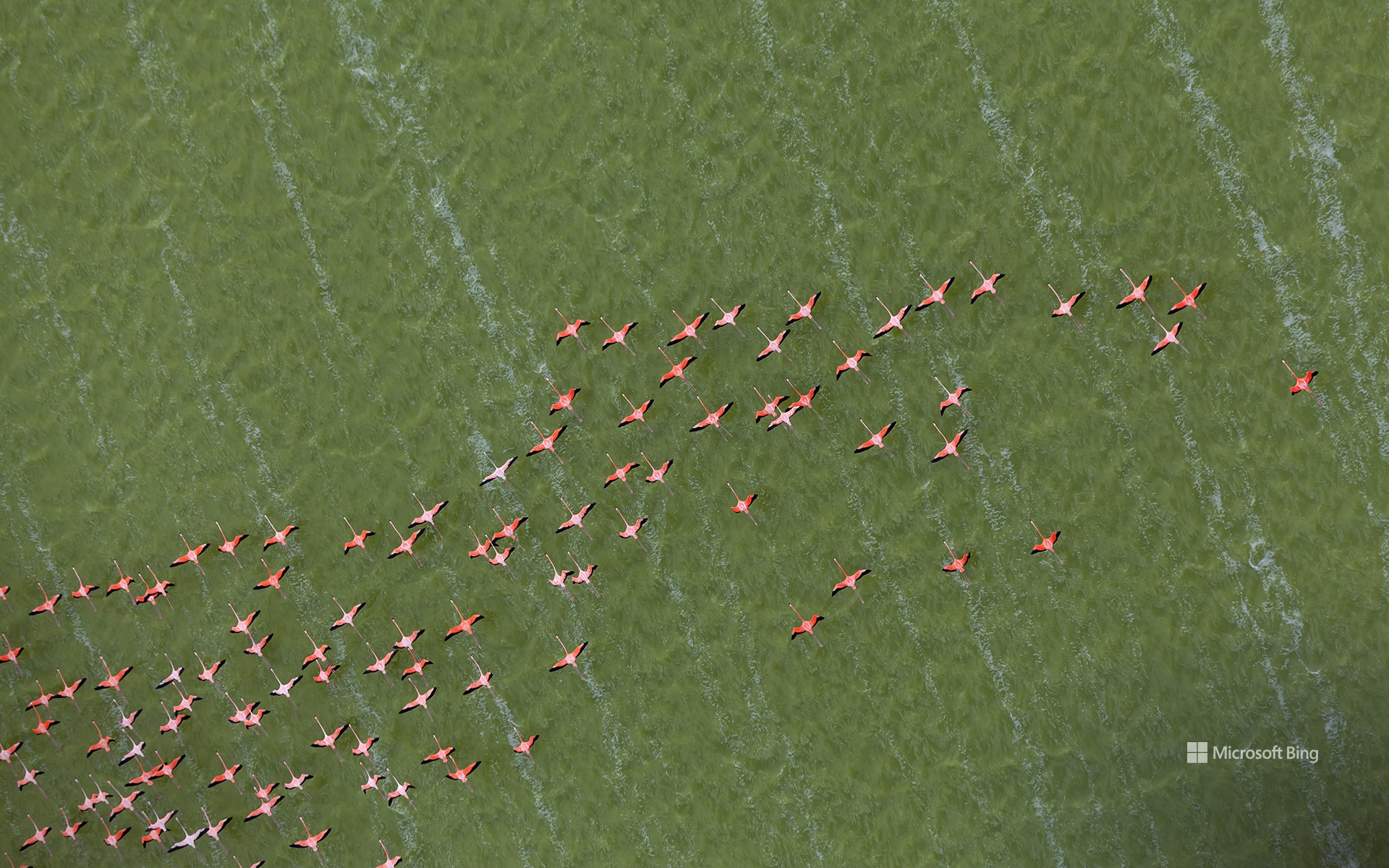
加勒比火烈鸟,尤卡坦半岛,墨西哥 Caribbean flamingos, Yucatán Peninsula, Mexico (© Claudio Contreras/NPL/Minden Pictures)
飞行中的火烈鸟 Flamboyance in flight
加勒比火烈鸟,尤卡坦半岛,墨西哥
你见过一群火烈鸟飞上天空吗?如果你见过,它们很有可能就是加勒比火烈鸟,也叫美洲火烈鸟,就像今天图片中在墨西哥尤卡坦半岛看到的那样。火烈鸟成群出没时被称为“火烈鸟群”,但它们也可以被称为“站群”或“群落”。加勒比火烈鸟是美洲最大的火烈鸟物种,也是唯一原产于北美的物种。这些充满活力的鸟类通常栖息在咸淡水和海水地区,如沼泽、河口和海岸线一带。由于其通体粉红色,它们经常被误认作粉红琵鹭。不过,长长的脖子和弯曲的喙将它们与大蓝鹭和木鹳等涉水鸟类区分开来。
加勒比火烈鸟分布在美国东南部、南美洲北部、加拉帕戈斯群岛和墨西哥尤卡坦半岛等地区,非常适合短途迁徙觅食。它们用长腿和有蹼的脚在浅水区捕食虾、甲壳类动物、软体动物、鱼类和藻类。它们的栖息地日益受到沿海开发、污染和海平面上升的威胁,使得种群处于危险之中。然而,当加勒比火烈鸟在天空中优雅地翱翔时,仍会让世人惊叹不已。
Caribbean flamingos, Yucatán Peninsula, Mexico
Ever seen a group of flamingos take to the skies? If you have, there's a good chance they were Caribbean flamingos, also known as American flamingos, as seen in Yucatán Peninsula, Mexico, in today's image. Flamingos are referred to as a flamboyance when in a group, but they can also be called a stand, colony, or pat. The Caribbean flamingo is the largest flamingo species in the Americas and the only one native to North America. These vibrant pink birds are typically found around brackish and saltwater areas, like marshes, estuaries, and along coastlines.
Found across regions like the southeastern United States, northern South America, the Galápagos Islands, and Mexico's Yucatán Peninsula, Caribbean flamingos are well adapted for short migrations in search of food. Using long legs and webbed feet, they hunt shallow waters for shrimp, crustaceans, mollusks, fish, and algae. Their habitats are increasingly threatened by coastal development, pollution, and rising sea levels, putting their population at risk. Yet, Caribbean flamingos still amaze us when they soar gracefully through the skies.
巢中的加勒比火烈鸟蛋,里奥拉加托斯自然保护区,尤卡坦州,墨西哥 Caribbean flamingo nests, Ría Lagartos Biosphere Reserve, Yucatán, Mexico (© Claudio Contreras/Minden Pictures)
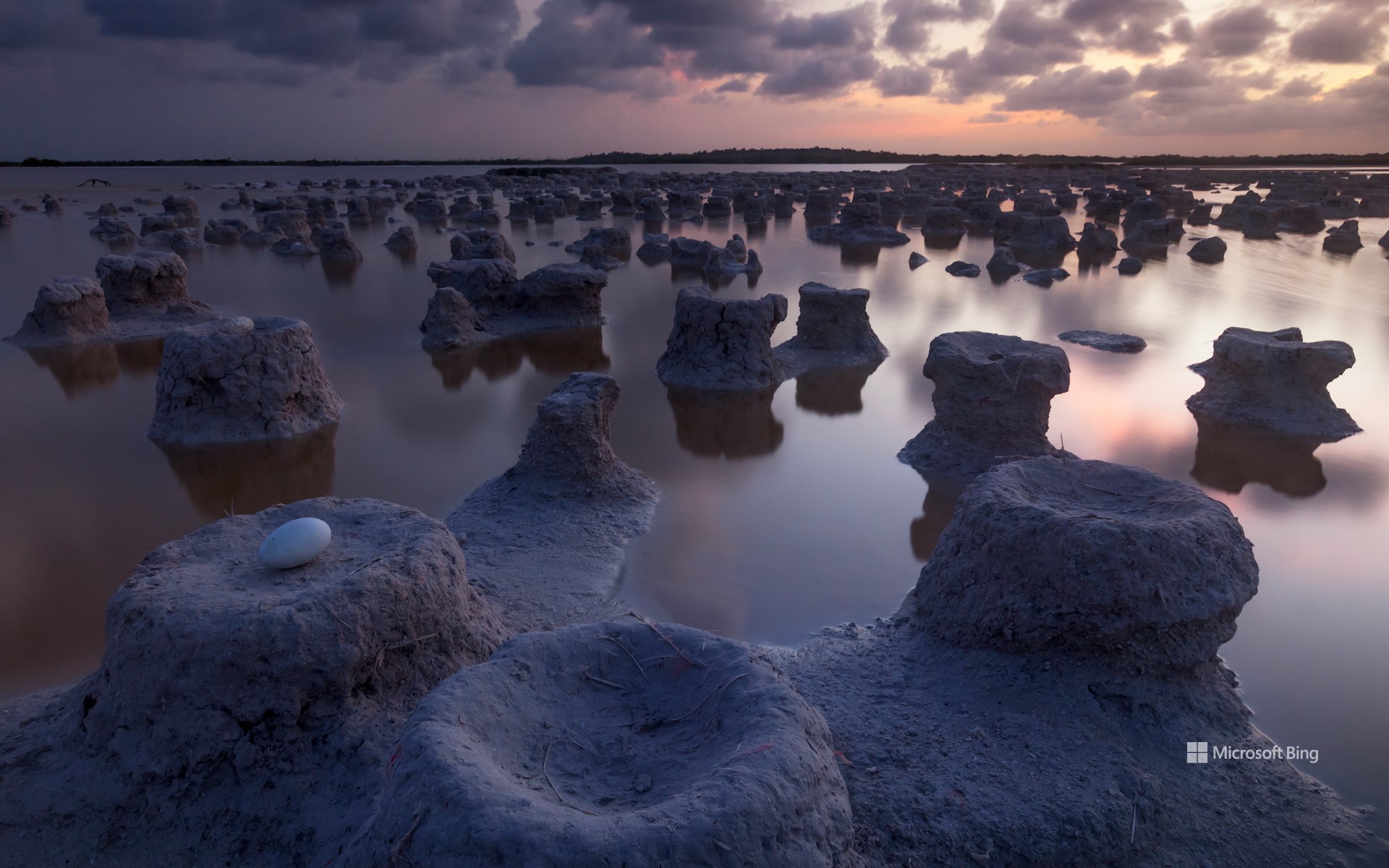
巢中的加勒比火烈鸟蛋,里奥拉加托斯自然保护区,尤卡坦州,墨西哥 Caribbean flamingo nests, Ría Lagartos Biosphere Reserve, Yucatán, Mexico (© Claudio Contreras/Minden Pictures)
自然与可持续发展的结合 Where nature meets sustainability
生物圈保护区国际日
今天是生物圈保护区国际日。生物圈保护区听起来像是一个复杂的科学术语,但从本质上讲,它们就是自然界的宝地:在这里,生物多样性非常丰富,地球上的各种生命蓬勃地生长。这些地区得到联合国教科文组织的认可,保持着生态系统的健康,保护着濒危物种,并通过森林、湿地和其他重要的栖息地调节气候。在136个国家里,有759个生物圈保护区。从印度孙德尔本斯郁郁葱葱的绿色植物到澳大利亚广袤无垠的大沙生物圈保护区,每个保护区都是独一无二的。
让我们来参观位于墨西哥尤卡坦州的里奥拉加托斯自然保护区。自2004年起,该地区成为联合国教科文组织的保护区。这里茂密的森林和稀树草原孕育着550多种脊椎动物,其中142种是这里独有的。这个保护区有超过400种鸟类,其中包括大量的火烈鸟,它们的巢穴在今天的图片中可以看到。生物圈保护区讲究平衡,里奥拉加托斯就是一个典型的例子。在这里,渔业、生态旅游、甚至盐业都是以尊重环境的方式进行的。
International Day for Biosphere Reserves
Today is the International Day for Biosphere Reserves. Biosphere reserves may sound like a mouthful, but they're essentially nature's sweet spots— biodiverse places that are home to a huge variety of life. These reserves, recognized by UNESCO, keep ecosystems healthy, protect endangered species, and help regulate climate through forests, wetlands, and other crucial habitats. There are 759 biosphere reserves across 136 countries. From the lush greenery of the Sundarbans in India to the vast expanses of the Great Sandy Biosphere Reserve in Australia, each reserve is unique.
Let's visit another—the Ría Lagartos Biosphere Reserve in Yucatán, Mexico, a UNESCO-protected sanctuary since 2004. Its forests and savannas cradle over 550 vertebrate species, including 142 species found only here. There are over 400 bird species in this reserve, including a large population of flamingos whose nests are seen in today's image. Biosphere reserves are all about balance, and Ría Lagartos is a prime example. Fishing, ecotourism, and even salt production are done in ways that respect the environment.
圣米格尔德阿连德的柱廊,瓜那华托州,墨西哥 Colonnade in San Miguel de Allende, Guanajuato, Mexico (© Mint Images/Getty Images)

圣米格尔德阿连德的柱廊,瓜那华托州,墨西哥 Colonnade in San Miguel de Allende, Guanajuato, Mexico (© Mint Images/Getty Images)
为墨西哥干杯! Cheers to Mexico!
五月五日节快乐!
五月五日节是墨西哥传统的爱国主义节日,这一活动不能与9月16日举行的墨西哥独立日混为一谈,20世纪80年代,由于龙舌兰酒、啤酒和葡萄酒的广告宣传,五月五日节在美国得到了认可,难怪如今的五月五日节在美国已成为一个狂欢的节日。值得一提的是,墨西哥除了美酒佳肴之外,丰富多彩的文化也值得品尝,无论是建筑(比如图中的圣米格尔德阿连德市的街道)、历史、艺术还是风景。
Happy Cinco de Mayo!
Today's homepage takes us to the Mexican city of San Miguel de Allende, to toast Cinco de Mayo, or 'Fifth of May.' Not to be confused with Mexico's Independence Day, Cinco de Mayo instead marks Mexico’s 1862 triumph over France at the Battle of Puebla. The holiday is observed in Mexico but has become popular in the US since the 1980s thanks to various advertising campaigns. Here it has evolved into a wider celebration of Mexican culture, whether it is food, history, art, or the colorful architecture of cities like San Miguel de Allende, established in the 16th century, a UNESCO World Heritage Site.
埃莫海滩,玛丽埃塔斯群岛,巴亚尔塔港,墨西哥 Playa del Amor in the Marietas Islands, off the coast of Puerto Vallarta, Mexico (© ferrantraite/Getty Images)
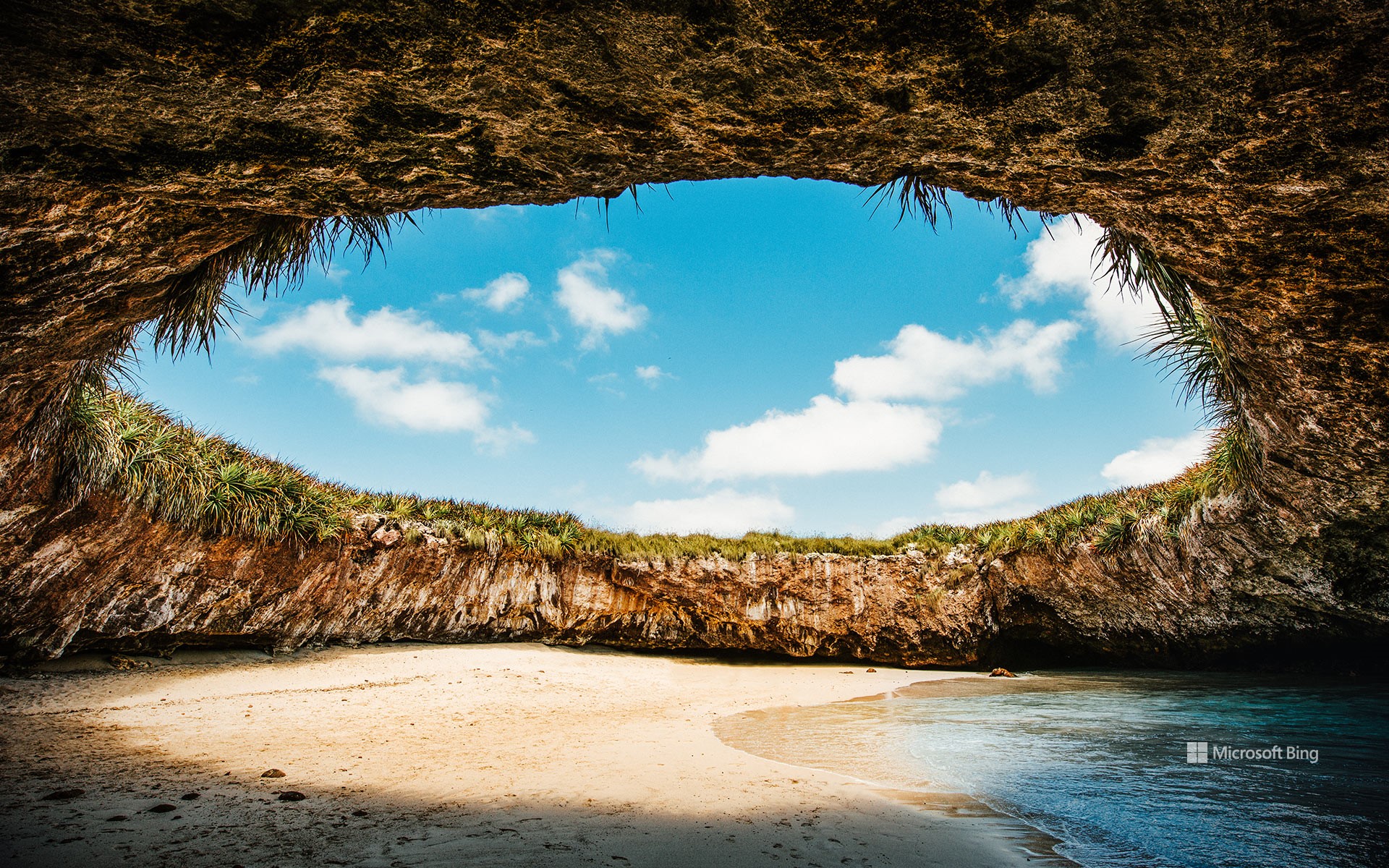
埃莫海滩,玛丽埃塔斯群岛,巴亚尔塔港,墨西哥 Playa del Amor in the Marietas Islands, off the coast of Puerto Vallarta, Mexico (© ferrantraite/Getty Images)
墨西哥的隐秘海滩 Secluded sands in Mexico
埃莫海滩,玛丽埃塔斯群岛,墨西哥
这张绝美的照片是在埃莫海滩拍摄的,这里又被称为“隐秘海滩”,位于墨西哥巴亚尔塔港西北处的偏远海岛,这里以其纯净的美景和独特的地貌而闻名。这处海滩只能通过一个自然侵蚀形成的隧道到达。沙滩和周围的岩壁组成了一个仰望天空的天窗,碧蓝的天空、绿松石色的海水、长满鲜花的崖壁相互映衬,景色独一无二。埃莫海滩又称“爱情海滩”,已经是一个热门的旅游目的地,但是为了保护这里的自然风景和生态环境,当地限制了游客数量。
Playa del Amor, Marietas Islands, Mexico
This gorgeous shot was taken at Playa del Amor—aka Hidden Beach—a remote destination off the coast of Puerto Vallarta, Mexico, known for its pristine beauty. To get to it, visitors need to take a boat toward the mouth of Banderas Bay at the base of the Marietas Islands. Once there, they swim through a tunnel at low tide to reach the beach. The walls hide a sandy cove, where the turquoise waters contrast with flora-laden cliffs that perfectly frame the blue sky overhead. Playa del Amor (Lovers' Beach) is popular among tourists, but the number of visitors is limited to preserve its natural beauty and ecosystem.
普埃布拉天主堂和波波卡特佩特火山,普埃布拉,墨西哥 Church of Nuestra Señora de los Remedios and Popocatépetl, Puebla, Mexico (© Radius Images/Shutterstock)
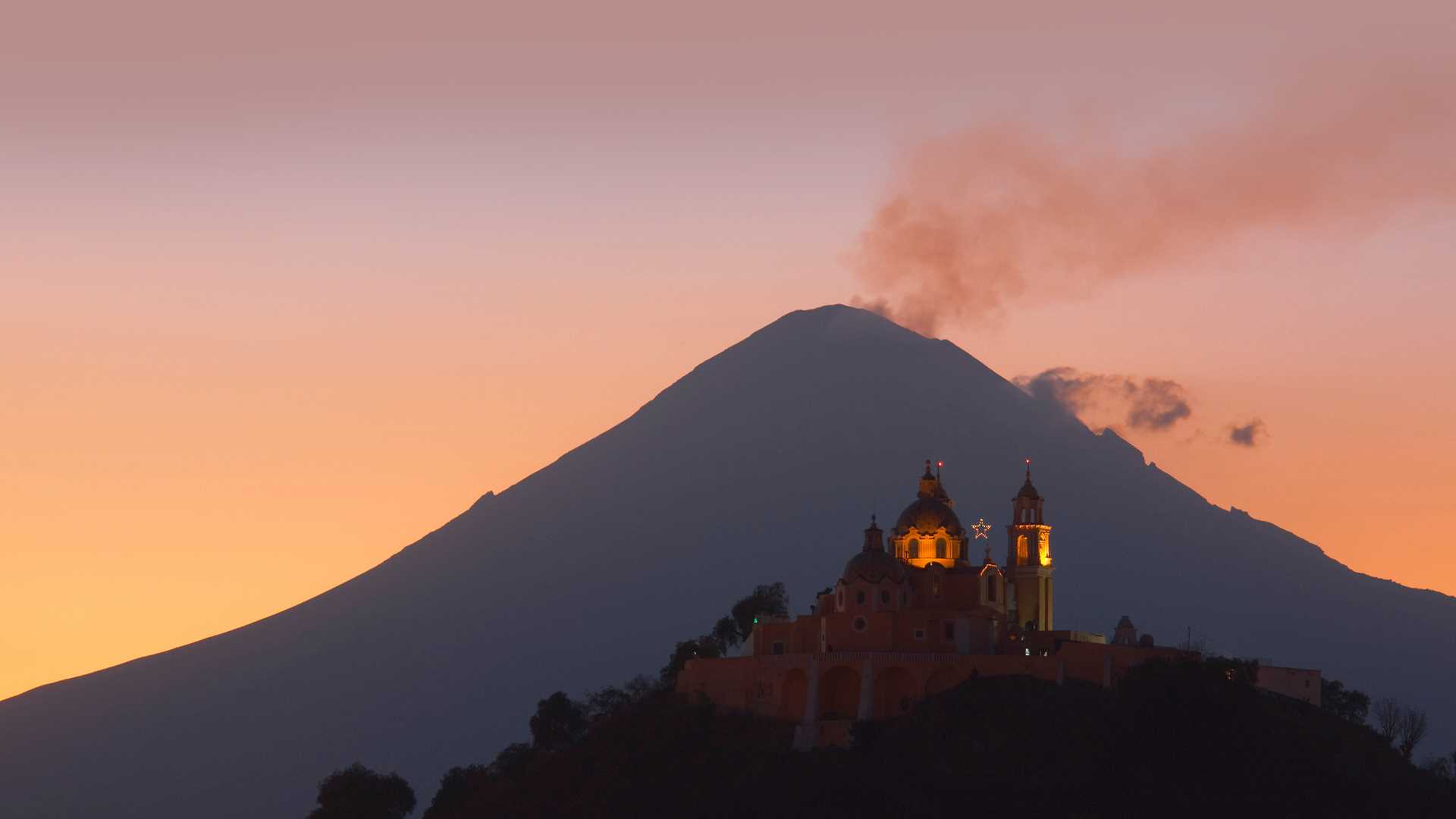
普埃布拉天主堂和波波卡特佩特火山,普埃布拉,墨西哥 Church of Nuestra Señora de los Remedios and Popocatépetl, Puebla, Mexico (© Radius Images/Shutterstock)
从胜利到欢庆 From victory to festivity
普埃布拉,墨西哥
与许多人的看法相反,5月5日并不是墨西哥的独立日。
真正的墨西哥独立日是在每年的9月16日庆祝。
而5月5日是为了庆祝在1862年的这一天墨西哥在普埃布拉战役中战胜法兰西帝国。虽然这一天是为了纪念一个重大的历史事件,但墨西哥的庆祝活动相对平静,主要集中在普埃布拉。
在墨西哥,这一天被称为“普埃布拉战役日”,因为当时的墨西哥总统贝尼托·巴勃罗·胡亚雷斯·加尔卡
(Benito Pablo Juárez Garca) 于 1862
年宣布这一节日为国定假日。今天,普埃布拉人民通过游行、演讲和战斗重演来庆祝。图中的 普埃布拉天主堂又称济世圣母教堂(Nuestra Señora
de los Remedios )在普埃布拉战役爆发时已经有将近 300 年的历史。
Cinco de Mayo
Contrary to what many people believe, Cinco de Mayo is not Mexico's Independence Day, which is celebrated on September 16. Instead, May 5 marks Mexico's victory over better-equipped French forces at the Battle of Puebla on May 5, 1862. Although the French Empire would counterattack and take the city a year later, the unexpected victory was a morale boost which still has symbolic significance. While in the US, Cinco de Mayo is a popular festival celebrating Mexican American culture, celebrations in Mexico are relatively quiet and focused mostly on Puebla.
In Mexico, the celebration became known as Battle of Puebla Day after President Benito Juárez declared it a national holiday in 1862. Today, the people of Puebla celebrate with parades, speeches, and battle reenactments. The Church of Nuestra Señora de los Remedios in Puebla, pictured here, was already nearly 300 years old when the 1862 battle was fought. And human history is just the blink of an eye to ancient Popocatépetl, the smoking volcano which towers over Puebla in the background of our homepage image.
潜水员探索文图拉斯港附近的水下天然井,墨西哥 Scuba diver exploring the underwater cenotes near Puerto Aventuras, Mexico (© Extreme Photographer/Getty Images)
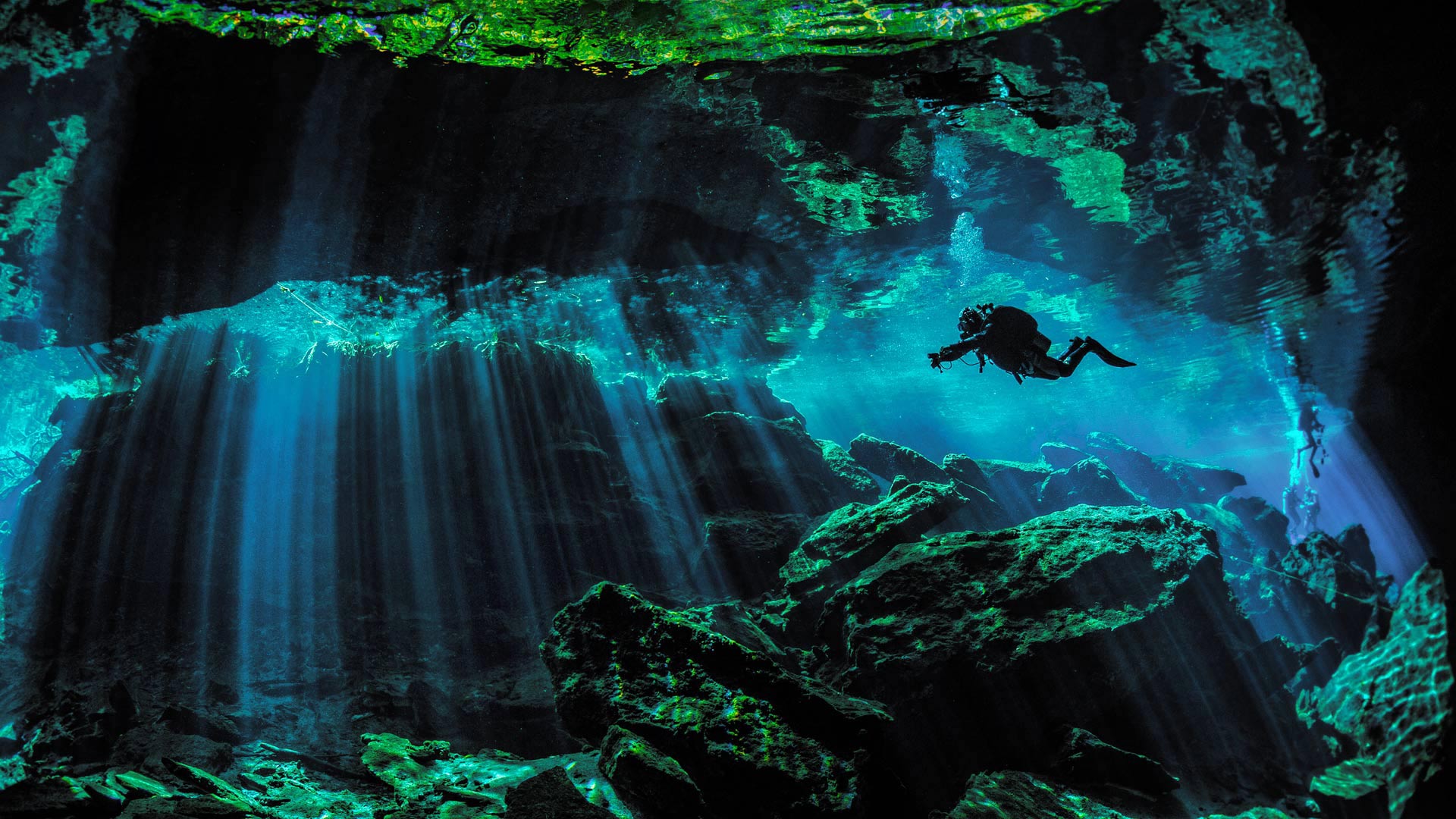
潜水员探索文图拉斯港附近的水下天然井,墨西哥 Scuba diver exploring the underwater cenotes near Puerto Aventuras, Mexico (© Extreme Photographer/Getty Images)
地面之下的水中世界 Underwater underground
Cenote near Puerto Aventuras, Mexico
Like a giant block of Swiss cheese, Mexico's Yucatan Peninsula is riddled with holes called cenotes. Cenotes form when subterranean limestone dissolves, allowing underground water to penetrate. The rock above may cave in, forming a pit and revealing the cool, often crystal-clear water, while other cenotes may remain hidden and unexplored. Cenotes vary in size from very small to several dozen yards across, and recent discoveries have shown that cenotes lead to a series of underground cave systems that can span several miles in length.
In a region with little rainfall and no rivers or streams, the Yucatan's 6,000 cenotes were vital to the many cities of the Mayan civilization that used them as a primary source of fresh water. While some of the peninsula's cenotes have a mix of salt water and fresh water, many of the holes have remarkably clean fresh water that has slowly filtered through rock. The diffuse light that reaches into the underground chambers creates a magical effect. It makes for fantastic swimming and diving opportunities. Many of the larger cenotes feature platforms and ropes to jump off, and they are often located near historically significant Mayan ruins.
墨西哥Aventuras港附近的Cenote
墨西哥的尤卡坦半岛就像一块巨大的瑞士奶酪,布满了被称为洞穴的洞。当地下石灰岩溶解时,会形成洞穴,使地下水渗入。上面的岩石可能会塌陷,形成一个坑,露出凉爽的,通常是水晶般清澈的水,而其他的洞穴可能仍然隐藏着,未经勘探。洞穴的大小从很小到几十码不等,最近的发现表明,洞穴形成了一系列地下洞穴系统,其长度可以跨越几英里。
在一个降雨量少、没有河流或溪流的地区,尤卡坦人的6000个纪念碑对玛雅文明的许多城市至关重要,玛雅文明将其作为淡水的主要来源。虽然半岛上的一些洞穴混合了咸水和淡水,但许多洞穴都有非常干净的淡水,这些淡水已经慢慢渗透到岩石中。进入地下室的漫射光创造了一种神奇的效果。它提供了绝佳的游泳和跳水机会。许多较大的纪念碑都有跳台和绳索,它们通常位于历史上重要的玛雅遗址附近。
蓝色龙舌兰田,墨西哥哈利斯科州龙舌兰酒产区 Tree in blue agave field in the tequila producing region near Atotonilco, Jalisco, Mexico (© Brian Overcast/Alamy)
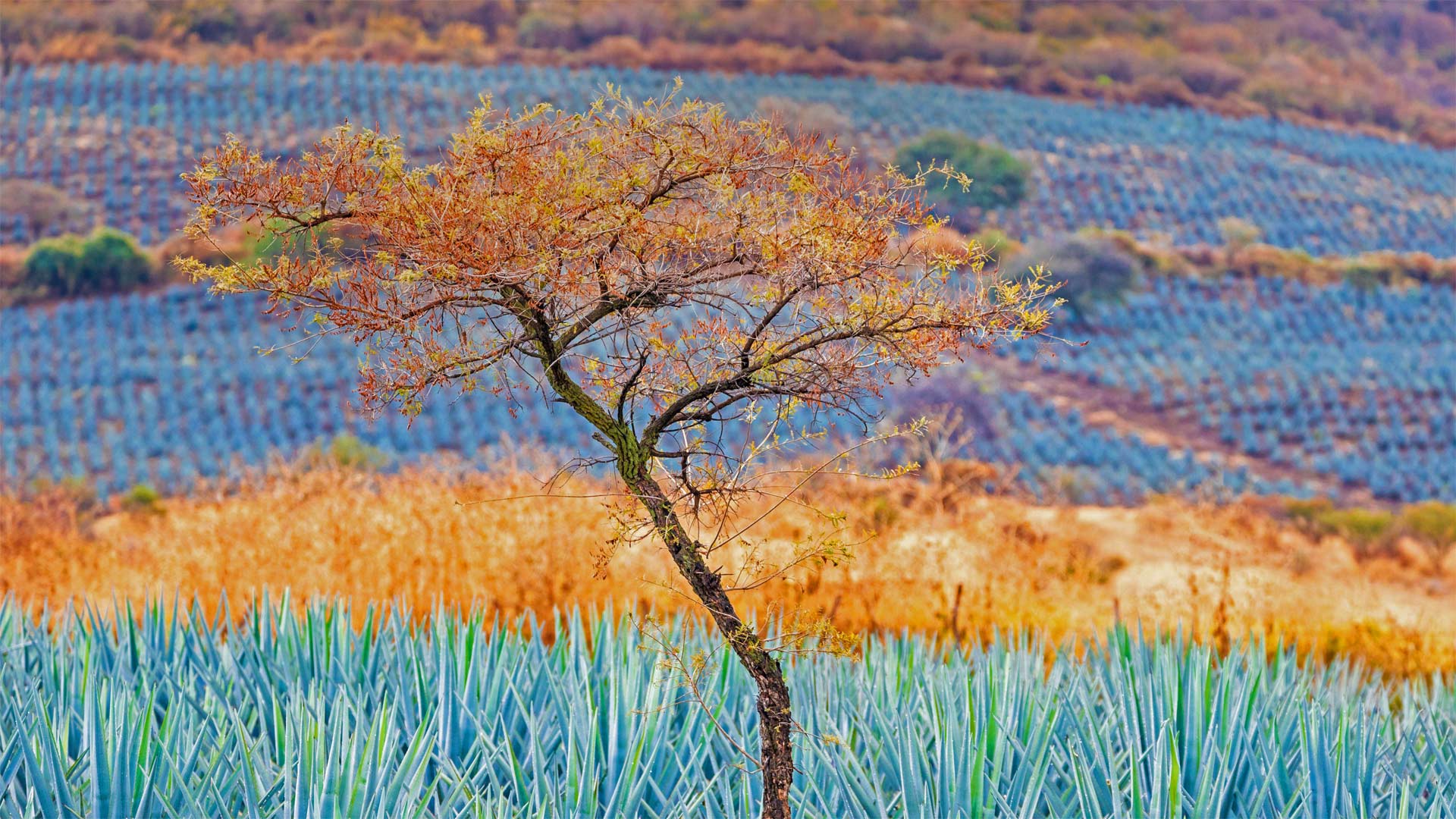
蓝色龙舌兰田,墨西哥哈利斯科州龙舌兰酒产区 Tree in blue agave field in the tequila producing region near Atotonilco, Jalisco, Mexico (© Brian Overcast/Alamy)
这种蓝色多汁的植物就像黄金一样珍贵 This blue succulent is as good as gold here
Cinco de Mayo
Many celebrations of Cinco de Mayo, or May 5, owe a debt to these rolling fields of blue agave, or agave Azul, the source material required to make genuine tequila. The distilled spirit is to Mexico what Scotch whisky is to Scotland and sake to Japan. Tequila is also the base ingredient in the beloved margarita cocktail certain to be served in abundance today.
Blue agave is native to Jalisco, a coastal state of Mexico, where it grows head-high in the rich sandy soils of Jalisco's highlands. Its flowers are pollinated, not by bees or birds, but by the Mexican long-nosed bat, adding to this succulent's mystique. The bat's favorite food is the pollen and nectar of agave. Tequila is made by roasting the heart of the plant and then crushing or squeezing it to release a sugary, clear liquid called aguamiel, which translates to honey water. That liquid is distilled to produce tequila. Authentic tequila, by law, can be made only in Jalisco and a few municipalities outside it, and its authenticity is protected by trade agreements.
Tequila's association with Cinco de Mayo in the US probably owes to the fact that Americans observe the day with an upbeat celebration of Mexican culture in general. Cinco de Mayo is sometimes mistaken for Mexico's Independence Day, which is actually on September 16. In Mexico, the holiday commemorates the Mexican army's victory over the French Empire in the Battle of Puebla in 1862. Whatever side of the border you're on today, if you toast the table with a glass of tequila, take a moment to remember the azure fields where it all started.
五月五日节
许多庆祝五月五日(Cinco de Mayo)的活动都要归功于这些蓝色龙舌兰(又称龙舌兰蓝)的滚滚田野,这是制作真正龙舌兰酒所需的原料。蒸馏酒之于墨西哥,就像苏格兰威士忌之于苏格兰,日本清酒之于日本。龙舌兰酒也是深受喜爱的玛格丽塔鸡尾酒的基本成分,今天一定会有大量的玛格丽塔鸡尾酒供应。
蓝色龙舌兰原产于墨西哥沿海州哈利斯科,生长在哈利斯科高地肥沃的沙质土壤中。它的花不是由蜜蜂或鸟类授粉,而是由墨西哥长鼻蝙蝠授粉,这增加了这种多汁植物的神秘性。蝙蝠最喜欢的食物是龙舌兰的花粉和花蜜。龙舌兰酒的制作方法是将植物的心脏烘烤,然后压碎或挤压,释放出一种称为aguamiel的含糖透明液体,转化为蜂蜜水。这种液体经过蒸馏制成龙舌兰酒。根据法律规定,正宗的龙舌兰酒只能在哈利斯科和其他几个城市生产,其真实性受到贸易协议的保护。
龙舌兰酒与美国的Cinco de Mayo酒的联系可能要归功于这样一个事实:美国人在庆祝这一天时,通常都会对墨西哥文化进行乐观的庆祝。Cinco de Mayo有时被误认为是墨西哥的独立日,实际上是9月16日。在墨西哥,这个节日是为了纪念墨西哥军队在1862年普埃布拉战役中战胜法兰西帝国。无论你今天身处何方,如果你用一杯龙舌兰酒来敬酒,花点时间回忆一下这一切开始的蔚蓝田野。
漫天飞舞的黑脉金斑蝶,墨西哥 Monarch butterflies in the Monarch Butterfly Biosphere Reserve, Angangueo, Mexico (© Sylvain Cordier/Minden Pictures)
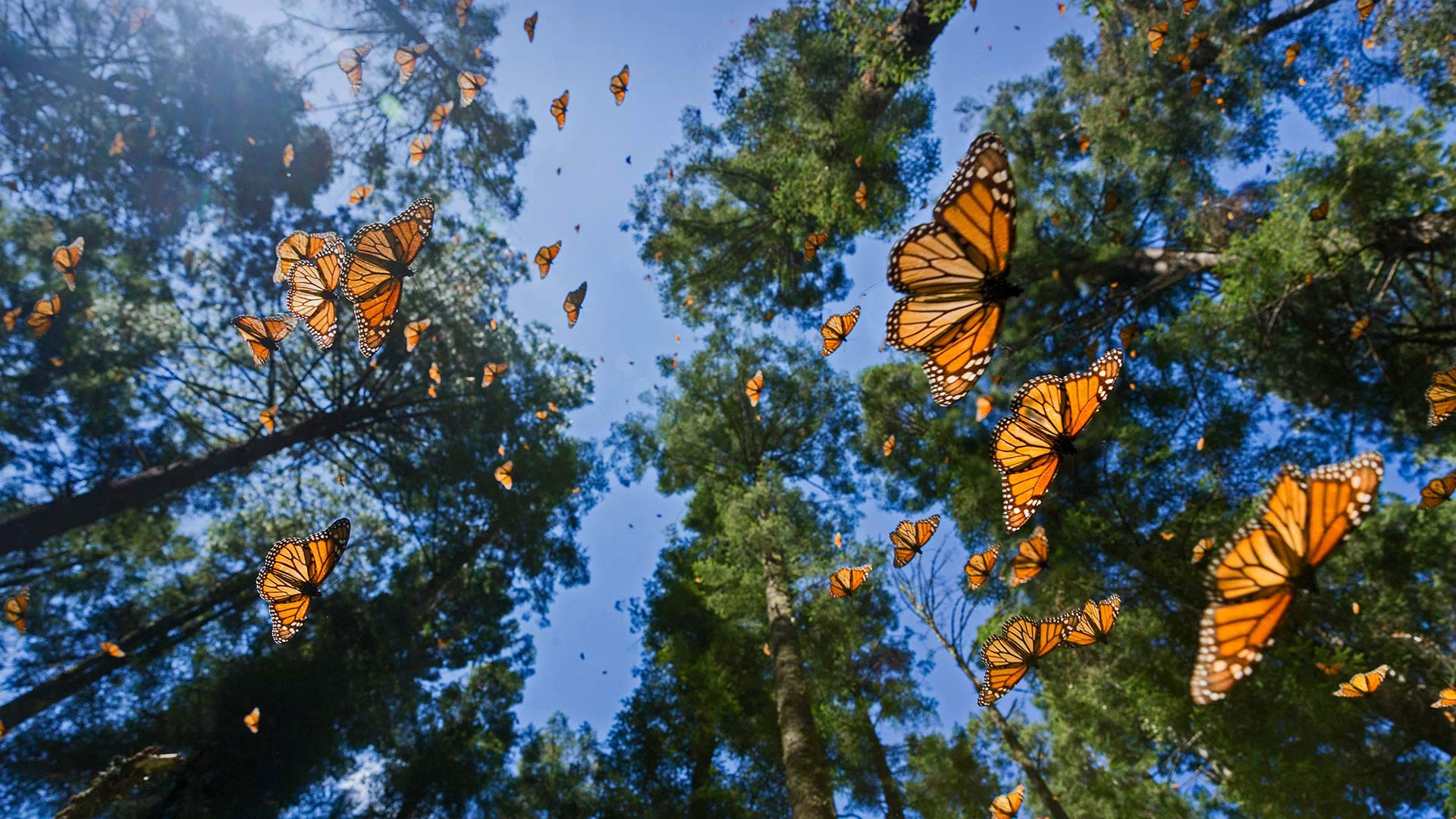
漫天飞舞的黑脉金斑蝶,墨西哥 Monarch butterflies in the Monarch Butterfly Biosphere Reserve, Angangueo, Mexico (© Sylvain Cordier/Minden Pictures)
Monarch butterflies in Angangueo, Mexico
Every year, one of the most spectacular natural phenomena in Mexico takes place in the forested mountains west of Mexico City. Between mid-January and late March, colonies of monarch butterflies migrate here from colder northern climates to find warmth and begin their breeding season. These huge flying colonies can contain as many as 20 million monarchs, which make use of air currents to travel as far as 100 nautical miles per day.
Upon arrival in the Mexican state of Michoacán, they'll settle into the forests of fir trees like those shown here, before finding their way to milkweed plants to mate and lay their eggs. The eggs will hatch after just a few days, leaving the offspring to feast on the milkweed before eventually transforming into the next generation of adult butterflies. Once the winter breeding season is over, the newly hatched monarchs will start the annual migration cycle over again, taking to the air for the long trek back north.
墨西哥Angangueo的帝王蝶
每年,墨西哥最壮观的自然现象之一发生在墨西哥城西部的森林山脉。1月中旬至3月下旬,成群的帝王蝶从寒冷的北方气候迁徙到这里,寻找温暖,开始繁殖季节。这些巨大的飞行殖民地可以容纳多达2000万只帝王,它们利用气流每天飞行100海里。
抵达墨西哥米却肯州后,它们会在这里所示的冷杉林中安顿下来,然后再找到马利筋植物交配产卵。卵在几天后就会孵化出来,让后代享用马利筋,然后最终转化为下一代成年蝴蝶。一旦冬季繁殖季节结束,新孵化的帝王将重新开始每年的迁徙周期,飞到空中进行漫长的向北跋涉。
亡灵节上点缀公墓的万寿菊,墨西哥米却肯州 (© Irwin Barrett/Design Pics/Alamy)
墨西哥城贝拉斯艺术宫 Palacio de Bellas Artes, Mexico City (© Lukas Bischoff Photograph/Shutterstock)
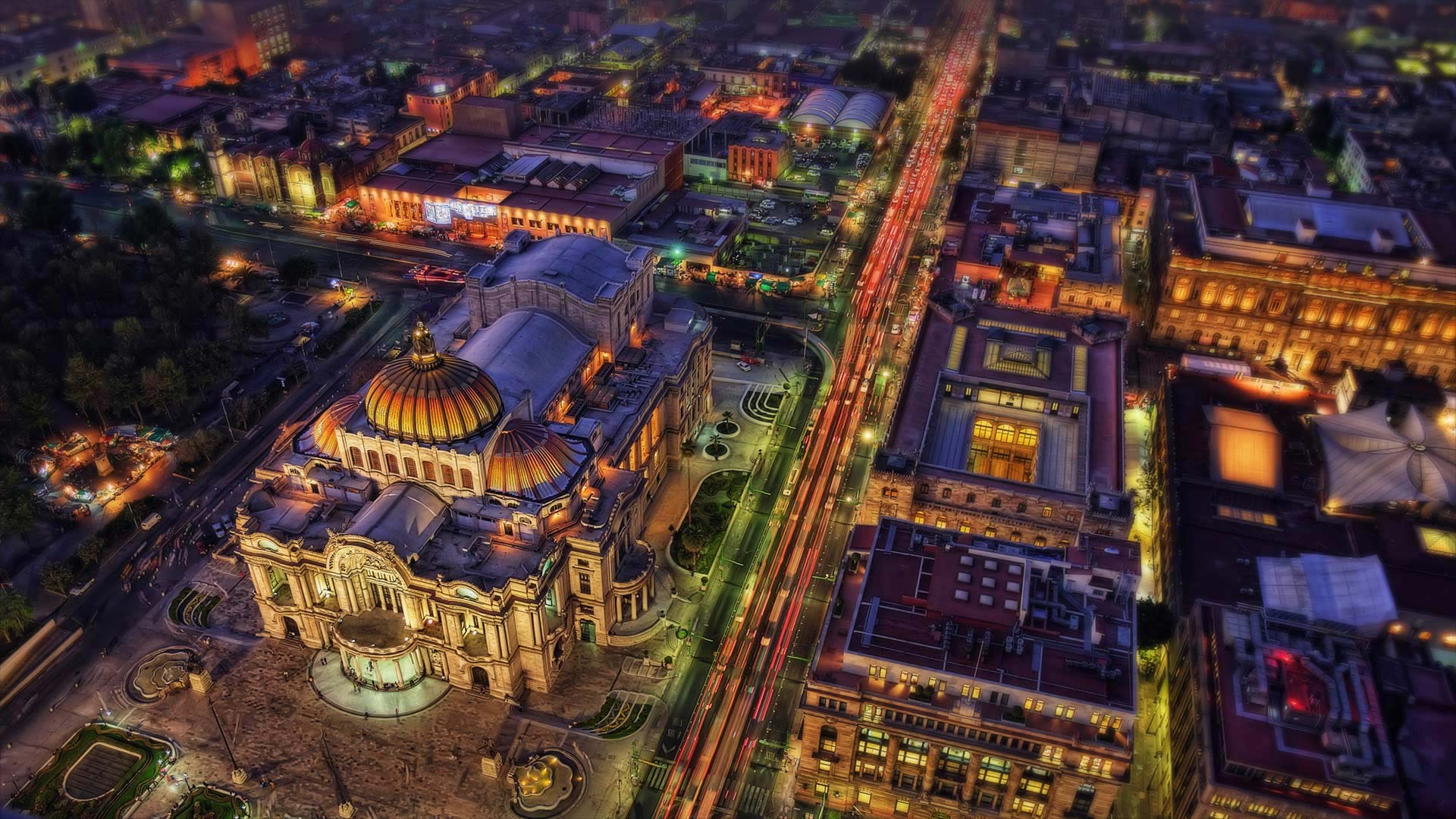
墨西哥城贝拉斯艺术宫 Palacio de Bellas Artes, Mexico City (© Lukas Bischoff Photograph/Shutterstock)
A cry for independence
The Palacio de Bellas Artes in Mexico City has hosted art exhibits, music and dance performances, and much more since its opening. The decadent Art Nouveau building opened in 1934 but was originally planned to open for Mexico's 100th birthday years earlier, in 1916. To get that story, we must travel 200 miles from this spot and back in time even further than the early 20th century.
On September 16, 1810, in Dolores, Mexico, the 'Cry of Dolores' rang out, signaling a call to arms. The Mexican War of Independence would last 11 years, finally breaking the country free from Spain. Though the war also ended in the month of September, it is the start of the conflict—September 16—that Mexicans celebrate as their Independence Day.
要求独立的呼声
墨西哥城的贝拉斯艺术宫自开业以来举办了艺术展览、音乐和舞蹈表演等活动。这座颓废的新艺术建筑于1934年开业,但最初计划在1916年墨西哥100岁生日时开业。为了得到这个故事,我们必须从这个地方走200英里,回到比20世纪初更远的时间。
1810年9月16日,在墨西哥的多洛雷斯,响起了“多洛雷斯的呐喊”,发出了武装的信号。墨西哥独立战争将持续11年,最终使该国脱离西班牙。虽然战争也在9月份结束,但墨西哥人庆祝的独立日是9月16日冲突的开始。
